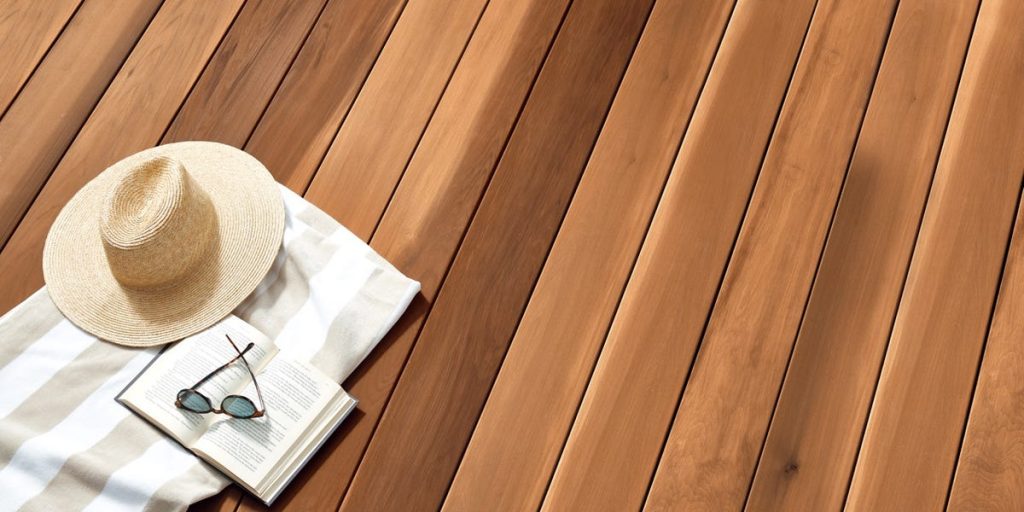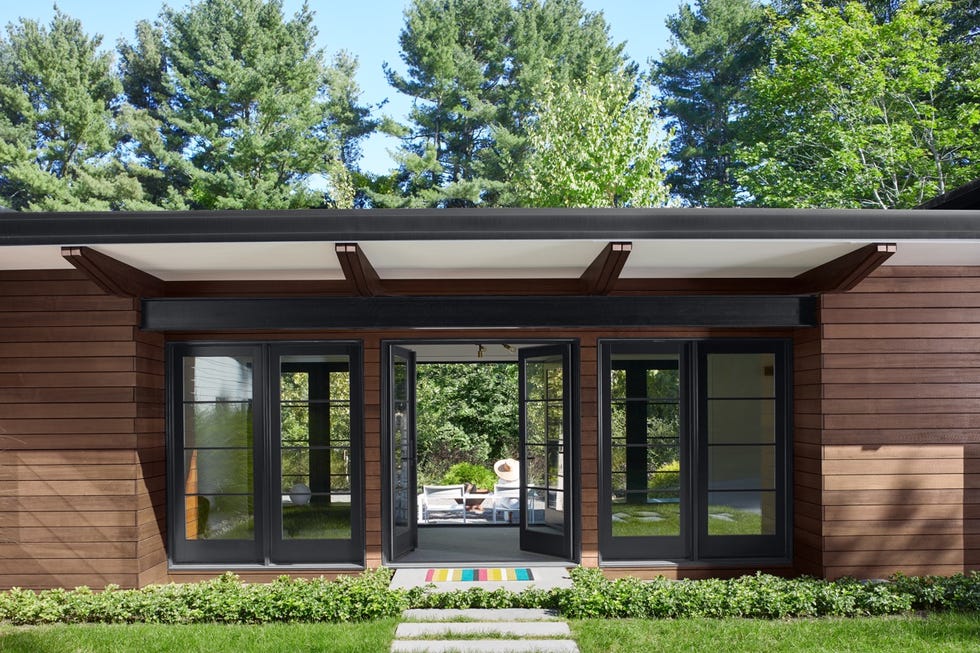Installing wooden fences, decks or siding can cost a small fortune (especially with lumber prices still sky-high) — which is why homeowners need these exterior features to last a long time. Enter wood stains, such as Benjamin Moore Woodluxe® line, which coat and protect outdoor wooden structures from the elements while enhancing the natural grain. In addition to preserving the integrity of the material and shielding boards from sun damage and frost, stains keep porches, fences and backyard chairs alike looking beautiful.
But that protection doesn’t last forever, so applying a coat of stain should be a regular home-maintenance task, just like HVAC servicing or inspecting your roof. And selecting the right product for your job starts with understanding the different types on the market. So to help break down popular formulations and transparencies, we spoke to some experts.
The Components of Stain
Stains consist of pigments or dyes suspended in a solvent. “The solvent gets the stain onto the wood, and then it evaporates,” says Caleb Roth, a Nashville-based stain expert and podcast host. Different types of stains utilize different solvents, such as water (more environmentally friendly) and chemicals like benzene and denatured alcohol.
Then there’s the pigments, often made of iron oxide: Think of them as suntan lotion, says Roth. “If you have a little bit of pigment, it’s like SPF 10. If you have a lot of pigment, like in a semi-transparent or semi-solid stain, it’s going to be SPF 200. Generally, the more pigment a stain has, the longer life it’s going to have,” he says. Stain formulations also include a binder (such as resin), which helps the pigment adhere to the wood, and additives that serve other purposes including protecting wood from water damage.
Pick Your Base
Wood stains come in three different formula types: Water-based, oil-based and hybrid. Typically, water-based stains are film-forming, “meaning that rather than going into the wood, they sit on top of the wood,” explains Roth. “They’re similar to paint in that they create a layer over the wood surface.” This is also one of their downsides: Since wood expands and contracts over time, film-forming stains are more prone to cracks that allow water to get inside, where it can create mold or start to rot the wood.
On the plus side, water-based stains are a more environmentally friendly option. And they offer more color options, says Brian Shaunfield, a Charlotte, NC based hardware store manager. “They also dry within a few hours and clean up easily with soap and water.”
Oil-based stains, on the other hand, penetrate deep into the wood and protect it from the inside out. “It’s sort of replacing the natural oils that are in the tree,” Roth says. “When you cut the tree down, there’s lots of natural oils there that dry out. And so if we can put oil back into the wood, the wood lasts longer and looks better.”
Oil-based stains also tend to be more durable and let the wood breathe—meaning if water does enter a board, it can wick itself through, preventing water damage and warping. However, they are messier and trickier to apply, and take longer to dry. They require using chemicals for clean-up and are higher in volatile organic compounds, or VOCs, making them less environmentally friendly. If you’re going with an oil-based stain, Roth stresses the importance of looking for one with “low-VOC” on the label.
Find Your Finish
“Choose a level of transparency based on the look and protection you want,” says Shaunfield. Clear stains have, as you’d expect, zero color and let the wood’s beautiful natural grain take center stage, but they usually need to be applied annually — especially in four-season climates or harsh winters. While it does add protection against water and UV light, this option allows your wood to turn gray naturally for that coveted weathered look. Roth says clear stains are especially great if you are working with red cedar: “You can achieve that silvery look that everybody loves.”
One tiny notch further on the color scale are transparent wood stains, which, according to Shaunfield, “have a slight tint and provide more protection than clear stains.” Semi-transparent stains are a bit more pigmented and work well for new or old wood. These types should be reapplied every two or three years. And semi-solid stains have even more pigmentation. “They work really well if you still want to see some wood grain, but maybe you’ve got really old wood or some mismatched boards,” says Roth. Finally, solid stains have rich color, hide most of the wood’s natural color and grain — so don’t use them on something made from beautiful or exotic hardwoods — and are a good option for seriously weathered boards. “They cover in a similar fashion to paint, and are best for fencing and outdoor furniture,” says Shaunfield.
One more thing to keep in mind is that exterior stain colors are either pre-tinted or tintable. Pre-tinted ones are ready to use in traditional shades of brown, while the tintable options are available in natural colors as well as fun options like green and blue. Benjamin Moore’s Woodluxe stains conveniently come in oil- and water-bases, four opacities and thousands of rich colors — so that no matter your project, you can find a stain that matches your needs.
Read the full article here
















